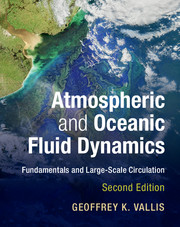Book contents
- Frontmatter
- Dedication
- Contents
- Preface
- Notation
- PART I FUNDAMENTALS OF GEOPHYSICAL FLUID DYNAMICS
- PART II WAVES, INSTABILITIES AND TURBULENCE
- 6 Wave Fundamentals
- 7 Gravity Waves
- 8 Linear Dynamics at Low Latitudes
- 9 Barotropic and Baroclinic Instability
- 10 Waves, Mean-Flows, and their Interaction
- 11 Basics of Incompressible Turbulence
- 12 Geostrophic Turbulence and Baroclinic Eddies
- 13 Turbulent Diffusion and Eddy Transport
- PART III LARGE-SCALE ATMOSPHERIC CIRCULATION
- PART IV LARGE-SCALE OCEANIC CIRCULATION
- References
- Index
11 - Basics of Incompressible Turbulence
from PART II - WAVES, INSTABILITIES AND TURBULENCE
Published online by Cambridge University Press: 09 June 2017
- Frontmatter
- Dedication
- Contents
- Preface
- Notation
- PART I FUNDAMENTALS OF GEOPHYSICAL FLUID DYNAMICS
- PART II WAVES, INSTABILITIES AND TURBULENCE
- 6 Wave Fundamentals
- 7 Gravity Waves
- 8 Linear Dynamics at Low Latitudes
- 9 Barotropic and Baroclinic Instability
- 10 Waves, Mean-Flows, and their Interaction
- 11 Basics of Incompressible Turbulence
- 12 Geostrophic Turbulence and Baroclinic Eddies
- 13 Turbulent Diffusion and Eddy Transport
- PART III LARGE-SCALE ATMOSPHERIC CIRCULATION
- PART IV LARGE-SCALE OCEANIC CIRCULATION
- References
- Index
Summary
TURBULENCE IS HIGH REYNOLDS NUMBER FLUID FLOW, dominated by nonlinearity, containing both spatial and temporal disorder. No definition is perfect, and it is hard to disentangle a definition from a property, but this statement captures the essential aspects. A turbulent flow has eddies with a spectrum of sizes between some upper and lower bounds, the former often determined by the forcing scale or the domain scale, and the latter usually by viscosity. The individual eddies come and go, and are inherently unpredictable. Rather like life, turbulent flows are endlessly fascinating and not a little frustrating.
The circulation of the atmosphere and ocean is, inter alia, the motion of a forced-dissipative fluid subject to various constraints such as rotation and stratification. The larger scales are orders of magnitude larger than the dissipation scale (the scale at which molecular viscosity becomes important) and at many if not all scales the motion is highly nonlinear and quite unpredictable. Thus, we can justifiably say that the atmosphere and ocean are turbulent fluids. We are not simply talking about the small-scale flows traditionally regarded as turbulent; rather, our main focus will be the large-scale flows associated with baroclinic instability and greatly influenced by rotation and stratification, a kind of turbulence known as geostrophic turbulence. However, before discussing turbulence in the atmosphere and ocean, in this chapter we consider from a fairly elementary standpoint the basic theory of two- and three-dimensional turbulence, and in particular the theory of inertial ranges. We do not provide a comprehensive discussion of turbulence; rather, we provide an introduction to those aspects of most interest or relevance to the dynamical oceanographer or meteorologist. In the next chapter we consider the effects of rotation and stratification, and after that we look at turbulent diffusion.
THE FUNDAMENTAL PROBLEM OF TURBULENCE
Turbulence is a difficult subject because it is nonlinear, and because, and relatedly, there are interactions between scales of motion. Let us first see what difficulties these bring, beginning with the closure problem itself.
The Closure Problem
Although in a turbulent flow it may be virtually impossible to predict the detailed motion of each eddy, the statistical properties — time averages for example — are not necessarily changing and we might like to predict such averages. Effectively, we accept that we cannot predict the weather, but we can try to predict the climate.
- Type
- Chapter
- Information
- Atmospheric and Oceanic Fluid DynamicsFundamentals and Large-Scale Circulation, pp. 413 - 444Publisher: Cambridge University PressPrint publication year: 2017



